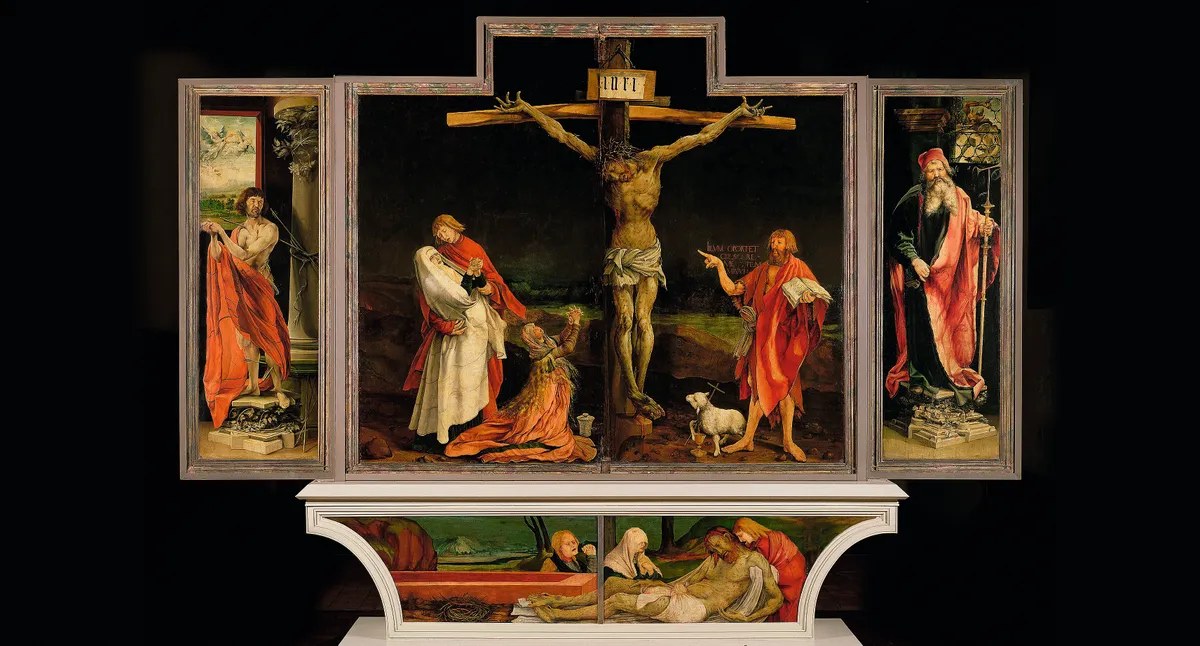For a brief period, Paul Hindemith appeared to have the musical world at his feet.
Internationally acclaimed during the early 1930s as a pedagogue and outstanding viola player, Paul Hindemith's position as the leading German composer of the younger generation seemed unassailable after securing prestigious commissions for new orchestral works from the Boston Symphony Orchestra and the Berlin Philharmonic in 1930 and ’32.
Alongside this breakthrough, he had cast off his earlier reputation as a musical iconoclast, modifying his creative outlook to embrace a more accessible style.
What is Mathis der Maler Symphony about?
A comparison of the subject matters of the two operas that frame this period neatly illustrates Hindemith’s significant change of direction.

Whereas Neues vom Tage (News of the Day), premiered in 1929, is a biting satire on the goings-on in a Berlin daily newspaper, Mathis der Maler (Mathis the painter), composed from 1933-34, is a profoundly serious work charting the life of the early-16th-century artist Matthias Grünewald, whose struggles to maintain freedom of expression caused him temporarily to abandon his profession and take up arms with the politically oppressed during the German Peasants’ War of 1524.
Why did Hindemith compose Mathis der Maler Symphony?
It was hardly coincidental that Hindemith should write an opera with this particular scenario at the very moment that Germany was experiencing almost unprecedented political turmoil. In early 1933, the Nazis’ rise to power had resulted in a haemorrhaging of the German musical scene, with the removal of many leading personalities that were deemed by the new regime to be unacceptable on aesthetic, political and/or racial grounds. Although Hindemith had good reason to fear for his own future, he nonetheless believed that he could win over the Nazis with his more recent compositions.
Driven by that objective, he enthusiastically accepted a request from conductor Wilhelm Furtwängler to write a new orchestral work for the Berlin Philharmonic’s 1933-34 season.
The commission could not have come at a more appropriate time, for it enabled him to showcase some of the music already composed for Mathis, which he hoped might help secure a staging of the complete opera. Initially, he contemplated compiling a suite drawing upon two interludes from the opera which were inspired by Grünewald’s paintings for the altarpiece at the Isenheim Abbey in Alsace. But after drafting a third and more extended movement, he decided to turn the work into a fully-fledged symphony.
How was Mathis der Maler Symphony received?
The Mathis der Maler Symphony, first performed in Berlin in March 1934, was such a success that many other German orchestras eagerly incorporated the work into their programmes. But Hindemith’s position proved to be anything but secure. Following a rumour that he had made disparaging remarks about Hitler while on tour outside Germany, zealous Nazis spearheaded a campaign to prevent further performances of the Symphony.
Things came to a head in November 1934 after Furtwängler had written a newspaper article staunchly defending the composer. Unfortunately, the conductor’s well-meaning support seriously backfired. The following month, propaganda minister Joseph Goebbels delivered a speech condemning Hindemith’s work as manifesting ‘drastic confirmation of how profoundly the Jewish intellectual infection has eaten into the body of our own people’.
After such a public outburst, Hindemith’s hopes of persuading any German opera house to stage Mathis were completely dashed. The situation became even more precarious after the Nazi government’s Reichsmusikkammer issued an official ban on all performances of Hindemith’s music in Germany. This action inevitably prompted the composer to sever ties with his native country – in 1938, he moved to Switzerland, where Mathis was given for the first time at the Zurich Opera, and two years later he settled in the US.
A guide to the music of Mathis der Maler Symphony
From our vantage point, it seems deeply ironic that the Mathis der Maler Symphony should have occasioned such opposition from the Nazis. After all, its stylistic ingredients, which draw so heavily upon German folksong and chorale, could hardly be described as decadent.
Indeed, listeners pigeonholing Hindemith as a sober neo-classicist will surely be surprised by the Romantic warmth of the Symphony’s first movement – entitled ‘Engelkonzert’ (Concert of Angels), its richly scored G major string chords and brilliant splashes of colour vividly project Grünewald’s image of Mary and the infant Jesus being serenaded by angels.
In contrast, the much more sombre second movement, ‘Grablegung’ (Entombment), depicts the crucified Jesus lying upon a tomb. Hindemith reserves his most dramatic music for the opening of the finale, ‘Versuchung des heiligen Antonius’ (The temptation of St Anthony), depicting St Anthony being viciously attacked by grotesque demons.
A more delicately scored section, inspired by Grünewald’s painting of St Anthony meeting St Paul the Hermit, provides a brief moment of repose before Hindemith places these demonic and consolatory elements into direct conflict with each other. But the closing passage, with the woodwinds intoning the 13th-century chant ‘Lauda Sion Salvatorem’, followed by a grandiose chorale in the brass, brings the Symphony to a strongly affirmative conclusion.
The best recordings of Hindemith's Mathis der Maler Symphony
Paavo Järvi (conductor)
Frankfurt Radio Symphony
Naïve V5434
Although Hindemith remains arguably the most deeply unfashionable and grievously underrated of all 20th-century masters, his Mathis der Maler Symphony has maintained its place in the repertoire and boasts a sizeable stream of fine recordings.
The high standards of performance were established from the very outset by the composer’s pioneering 1934 recording in which he conducted the Berlin Philharmonic. Over 20 years later, the same forces came together to record the work again for Deutsche Grammophon, a benchmark performance of great warmth and intensity captured in decent mono sound, although lacking perhaps the depth and clarity of engineering that would be found in more recent releases.
Between the 1960s and ’90s, the Symphony became very much the province of leading American orchestras. Classic recordings include the warmly Romantic interpretations from Eugene Ormandy and the Philadelphia (Sony), and the same orchestra conducted by Wolfgang Sawallisch (Warner). More dispassionate accounts have been offered by William Steinberg and the Boston Symphony (DG) and the fleet-footed Herbert Blomstedt and the San Francisco Symphony Orchestra (Decca). Every one of these performances boasts wonderfully manicured playing, and almost all of them have justifiably garnered critical acclaim.
Yet the Mathis der Maler Symphony amounts to far more than a dazzling orchestral showpiece. A top recommendation in such a highly competitive field therefore has to bring something more. In this respect, Paavo Järvi and the Frankfurt Radio Symphony Orchestra’s live 2010 recording really does stand out from the crowd. Almost like a picture restorer revealing the original colours of a faded masterpiece for the first time, Järvi reinvigorates Hindemith’s score, highlighting innumerable subtle details of texture, balance and phrasing often missed in many other recordings.
Such a forensic approach could so easily sound over-fussy and self-conscious, yet Järvi never loses sight of the overarching trajectory of each movement. Adopting eminently sensible tempos throughout, his interpretation conveys all the drama and textural variety of Hindemith’s musical invention with burning intensity. Naïve’s recording is ideal, combining depth of orchestral sound with an admirable clarity that allows one to savour every strand in Hindemith’s linear writing.
Leonard Bernstein (conductor)
DG 429 4042
Nobody rivals the sheer theatricality of Bernstein’s approach to Hindemith’s final movement in this live account from 1989. The menacing string threnody at the opening conjures up an almost Mahlerian vision of the Apocalypse before plunging us headlong into the scariest ride through the gates of Hell.
Though the dryish recording doesn’t give much bloom to the Israel Philharmonic’s woodwind and brass, there’s a palpably vivid sense of struggle between good and evil later in the movement, resolved in arguably the most heart-warming apotheosis of the Symphony on disc.
Claudio Abbado (conductor)
DG 447 3892
In this 1995 recording, Abbado invests Hindemith’s ‘Concert of Angels’ with lyrical warmth and tenderness. Exquisite phrasing of the woodwind solos in the slow introduction is followed by radiant bursts of orchestral colour at the climaxes in the ensuing faster section.
The full-blooded passages in ‘Entombment’ are suitably dark and majestic, providing a stark contrast to some breathtakingly hushed string timbres near the opening. The Berlin Philharmonic relishes the considerable technical challenges of the final movement, delivering some mind-blowingly fast string passage work near the end.
Esa-Pekka Salonen (conductor)
Sony G010003835294B
Like Paavo Järvi’s, this 2018 recording offers a fresh yet deeply considered interpretation, highlighting some of the music’s darker resonances.
The opening bars to ‘Concert of Angels’, with Salonen’s noticeably slower tempo and halting phrasing tinged with an unexpected feeling of sadness, are particularly distinctive. Also admirable are his imposing, almost Brucknerian approach to the second movement and a vividly expressionist projection of the opening to the finale. The Los Angeles Philharmonic responds incisively to the score’s every twist and turn, and the recording is excellent.
And one to avoid…
In his 1972 recording, Jascha Horenstein secures some fine playing from the LSO, especially in the first two movements, and the recorded sound is perfectly acceptable. But the impossibly slow tempo he adopts in the ‘Sehr Lebhaft’ section early in the finale is a serious miscalculation, robbing the music of its elemental power and making Hindemith’s invention sound turgid and mechanical.
